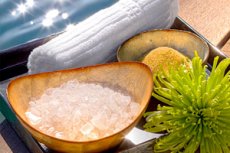Medical expert of the article
New publications
Cosmetic methods to fight cellulite
Last reviewed: 08.07.2025

All iLive content is medically reviewed or fact checked to ensure as much factual accuracy as possible.
We have strict sourcing guidelines and only link to reputable media sites, academic research institutions and, whenever possible, medically peer reviewed studies. Note that the numbers in parentheses ([1], [2], etc.) are clickable links to these studies.
If you feel that any of our content is inaccurate, out-of-date, or otherwise questionable, please select it and press Ctrl + Enter.

Anti-cellulite preparations are usually produced in the form of gels and creams, and anti-cellulite biologically active substances (BAS) are included in lotions, soaps and scrubs.
Read also: How to get rid of cellulite on your legs: 5 effective ways
A popular component of anti-cellulite cosmetics are brown seaweeds Laminaria and Fucus. In English-speaking countries they are called "seaweed", and in Russian-speaking countries - "seaweed". Most often used are various types of Laminaria (Laminaria japonica, L. ochroleuca, L. digitata, L. saccharina) and Fucus vesiculosis. Algae extracts stimulate beta-adrenergic receptors of fat cells and enhance lipolysis, improve water-salt metabolism in subcutaneous fat tissue and the outflow of tissue fluid, remove toxins and waste products of cells, improve the tone of the skin and blood vessels.
The second most common component is xanthine derivatives (caffeine, etc.), either in pure form or as plant extracts. These are extracts of coffee (Coffea arabica; contains caffeine, theobromine), cocoa (Theobroma cacao; caffeine, theobromine), guarana (Paulinia cupana; caffeine, theophylline, xanthine, guanine, hypoxanthine), cola (Cola acuminata; caffeine, theobromine, kolanine), tea (Thea sinensis; caffeine, theobromine, theophylline, xanthine, dimethylxanthine), mate (Ilex paraguariensis; caffeine, theobromine).
Read also: Cellulite: where does the unappetizing "orange peel" come from?
Anti-cellulite cosmetics also contain antioxidant vitamins C and E, as well as vitamins B5 and B6, which are necessary for normal regeneration of skin cells.
Thalassotherapy
Thalassotherapy is the oldest method of combating cellulite. It is the use of the beneficial effects of the marine environment: climate, water, mud, algae, sand and other components extracted from the sea. A course of thalassotherapy improves the condition of the nervous and endocrine systems, on which the balance of lipolysis and lipogenesis, as well as water-salt metabolism, depend.
Wraps
Wraps are one of the modifications of thalassotherapy. In modern cosmetology, wraps based on brown seaweed with the addition of other components of plant origin are widely practiced (in combination with massage and the use (before and after wrapping) of scrubs, peelings, lotions, sprays and creams).
Mesotherapy
During mesotherapy, micro-quantities of cocktails made up of anti-cellulite components are injected into the skin, which then slowly spread from the injection area into the surrounding tissues and, presumably, “melt” fat deposits, tone blood vessels, reduce swelling, stimulate cell respiration, etc. This allows all these substances to be delivered to the subcutaneous tissue, and delivered locally, without spreading them throughout the body.
All plant ingredients that are included in anti-cellulite cosmetics - extracts of Centella asiatica (Gotu Kola), coffee, cocoa and tea, brown and red seaweed (Laminaria japonica, L. digitata, L. sacharina, Fucus vesiculosus), cola, guarana, ginkgo, horse chestnut, etc. - can be included in the composition of mesotherapeutic cocktails. Carnitine and coenzyme Q10 are used to stimulate respiration and cell metabolism.
Mud therapy
Mud therapy, like thalassotherapy, is also an ancient method of combating cellulite. Therapeutic mud is a complex natural biochemical complex that has a multifaceted effect on the human body. The composition of therapeutic mud depends on its origin - mud can be silt, sapropel, peat, etc., from estuaries, salt and freshwater lakes, etc. Mud retains heat for a long time and slowly releases it to the body during the procedure. Under the influence of thermal therapy, blood vessels expand, blood and lymph flow improves. In addition, therapeutic mud contains a number of biologically active substances - mineral and organic compounds, vitamins and biogenic stimulants, and some components of the mud absorb skin secretions, helping to cleanse the skin.
Lymphatic drainage
In aesthetic medicine, courses of hardware lymphatic drainage occupy one of the leading places in body modeling programs. Lymphatic drainage is perfectly combined with other methods of cellulite treatment (wraps, creams, dietary supplements, diets) and enhances their positive results.
Hardware effects affect many processes in connective and muscle tissue, helping to relieve congestion. Hardware massages often use creams with menthol, camphor, aminophylline or theophylline, which stimulate lipolysis.
Anti-cellulite cosmetics
It is known that the leading role in the pathogenesis of cellulite is played by:
- local hypertrophy of fat cells (adipocytes);
- microcirculation disorder with the development of edema;
- inflammation;
- proliferation of connective (fibrous) tissue.
Therefore, a competent figure correction program is designed in such a way as to ensure:
- accelerated breakdown of triglycerides in adipose tissue into fatty acids (activation of lipolysis, blocking of mechanisms that inhibit lipolysis, stimulation of blood circulation);
- utilization (burning) of fatty acids (stimulation of blood circulation and muscle contraction);
- elimination of edema and congestion (stimulation of blood circulation, lymphatic drainage, strengthening of vascular walls, anti-varicose therapy).


 [
[